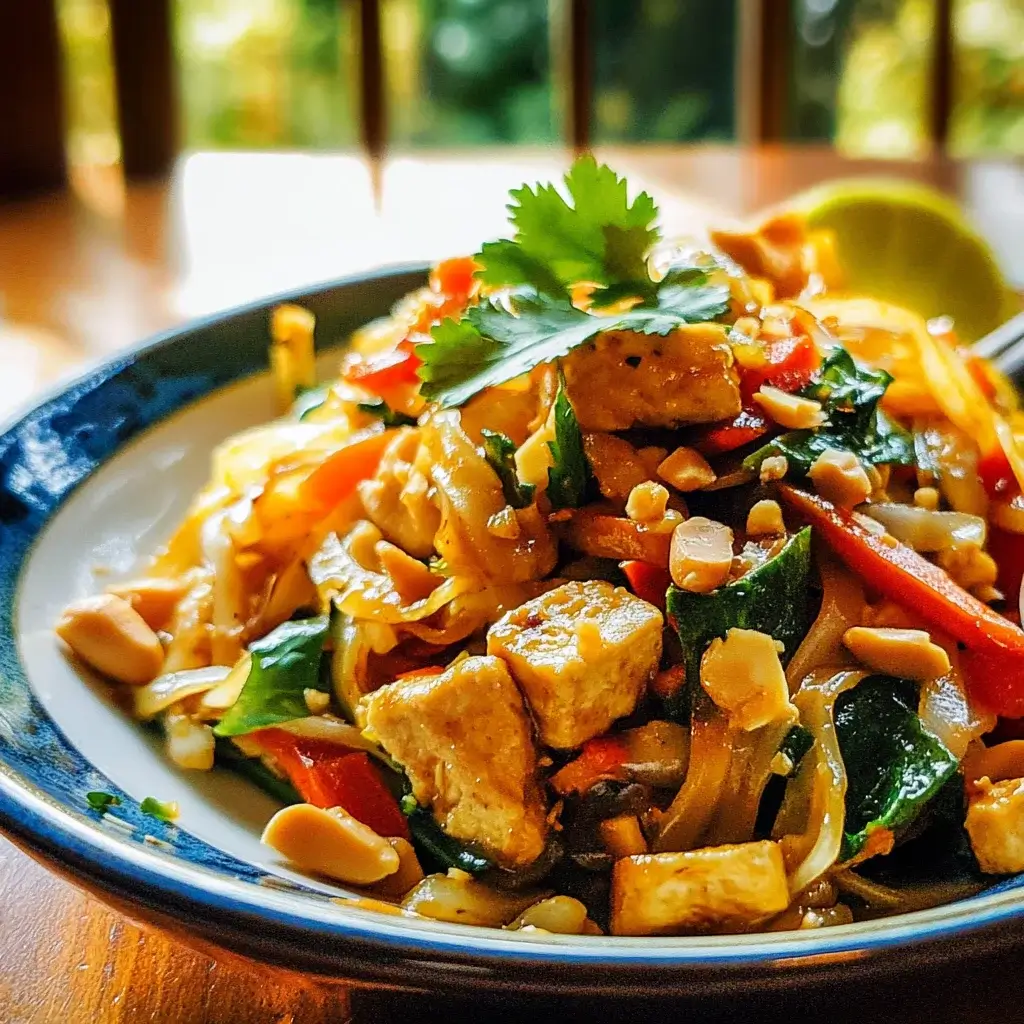There’s a certain magic that happens when vibrant vegetables meet a luscious, nutty sauce, and this Vegetarian Thai Peanut Stir-Fry is a prime example. In my kitchen, weeknight dinners are often a balancing act between speed, health, and, most importantly, flavor. This recipe has become a consistent winner, not just for its simplicity but for the chorus of “mmmms” and “can I have seconds?” I hear from my family every time it graces our table. Even my veggie-skeptic teenager devours it, proving that this dish has a universal appeal. The combination of crisp-tender vegetables, protein-packed tofu, and that irresistible peanut sauce is a symphony of textures and tastes that will transport you straight to the bustling streets of Thailand, all from the comfort of your own kitchen. Get ready to experience a vegetarian stir-fry that’s anything but ordinary!
Ingredients for a Flavorful Vegetarian Thai Peanut Stir-Fry
- Tofu (1 block, firm or extra-firm, pressed): The protein powerhouse of this dish, tofu soaks up the flavors beautifully and provides a satisfying chewiness. Pressing it removes excess water, ensuring it gets wonderfully crispy when stir-fried.
- Broccoli Florets (1 large head, cut into bite-sized pieces): Broccoli adds a vibrant green color, a slightly earthy flavor, and a delightful crunch. It’s packed with nutrients and holds up well in a stir-fry.
- Bell Peppers (2, any color, sliced): Bell peppers contribute sweetness and a satisfying crispness. Use a mix of colors for visual appeal and a variety of vitamins.
- Carrots (2, julienned or thinly sliced): Carrots bring a touch of sweetness and a beautiful orange hue. Julienne or thin slices cook quickly and evenly in the stir-fry.
- Snap Peas (1 cup, trimmed): Snap peas offer a delightful sweetness and a satisfying “snap” when you bite into them. They add a lovely texture contrast to the dish.
- Red Onion (1/2, thinly sliced): Red onion provides a pungent and slightly sweet flavor that adds depth to the stir-fry. It caramelizes slightly when cooked, enhancing its taste.
- Garlic (3 cloves, minced): Garlic is essential for building flavor in almost any savory dish. It brings a pungent aroma and a delicious savory note.
- Ginger (1 tablespoon, grated or minced): Fresh ginger adds a warm, spicy, and slightly citrusy flavor that is characteristic of Thai cuisine.
- Vegetable Oil (2 tablespoons, high-heat oil like canola or peanut): A high-heat oil is crucial for stir-frying at high temperatures without burning, ensuring crispy vegetables and tofu.
- Soy Sauce (1/4 cup, low sodium): Soy sauce provides a salty, umami base for the peanut sauce and stir-fry. Low sodium helps control the overall saltiness.
- Peanut Butter (1/2 cup, creamy or crunchy): The star ingredient! Peanut butter creates the signature creamy, nutty flavor of the Thai peanut sauce. Choose creamy for a smoother sauce or crunchy for added texture.
- Rice Vinegar (2 tablespoons): Rice vinegar adds a tangy and slightly sweet acidity that balances the richness of the peanut butter and soy sauce.
- Honey or Maple Syrup (2 tablespoons): A touch of sweetness is needed to round out the flavors of the peanut sauce. Honey or maple syrup work equally well. For a vegan option, use maple syrup.
- Lime Juice (1 tablespoon, fresh): Fresh lime juice brightens the sauce with a zesty citrus note and adds a refreshing element.
- Sesame Oil (1 teaspoon, toasted): Toasted sesame oil adds a nutty aroma and flavor that enhances the overall taste of the stir-fry and sauce.
- Red Pepper Flakes (1/2 teaspoon, or to taste): Red pepper flakes provide a touch of heat. Adjust the amount to your spice preference. Omit if you prefer a completely mild dish.
- Water (2-4 tablespoons, or as needed to adjust sauce consistency): Water helps thin out the peanut sauce to your desired consistency.
- Cooked Rice or Noodles (for serving): Serve the stir-fry over your choice of cooked rice (white, brown, or jasmine) or noodles (rice noodles, egg noodles, or ramen).
- Optional Garnishes: Chopped peanuts, sesame seeds, fresh cilantro, chopped green onions, lime wedges.
Instructions: Crafting Your Flavorful Vegetarian Thai Peanut Stir-Fry
- Prepare the Tofu: Begin by pressing the tofu to remove excess water. Place the tofu block between paper towels or clean kitchen towels, and then put a heavy object (like a stack of books or a cast iron pan) on top. Press for at least 20-30 minutes. This step is crucial for achieving crispy tofu. Once pressed, cut the tofu into bite-sized cubes.
- Make the Peanut Sauce: In a medium bowl, whisk together the soy sauce, peanut butter, rice vinegar, honey or maple syrup, lime juice, sesame oil, and red pepper flakes. Start with 2 tablespoons of water and whisk until the sauce is smooth. If the sauce is too thick, add more water, one tablespoon at a time, until it reaches your desired consistency. Taste and adjust seasonings as needed. You might want to add a little more lime juice for tanginess, honey for sweetness, or red pepper flakes for heat. Set the peanut sauce aside.
- Prepare the Vegetables: While the tofu is pressing and you’re making the sauce, prepare your vegetables. Wash and chop the broccoli into florets, slice the bell peppers, julienne or thinly slice the carrots, trim the snap peas, and thinly slice the red onion. Mince the garlic and grate or mince the ginger. Having all your vegetables prepped and ready to go is key for efficient stir-frying.
- Stir-Fry the Tofu: Heat 1 tablespoon of vegetable oil in a large wok or skillet over medium-high heat. Once the oil is hot and shimmering, add the cubed tofu. Stir-fry the tofu for 5-7 minutes, or until it is golden brown and crispy on all sides. Remove the tofu from the wok and set aside.
- Stir-Fry the Vegetables: Add the remaining 1 tablespoon of vegetable oil to the wok. Add the sliced red onion and stir-fry for 2-3 minutes, until it softens slightly and becomes fragrant. Then, add the minced garlic and ginger and stir-fry for another minute until fragrant. Be careful not to burn the garlic and ginger.
- Add the Heartier Vegetables: Add the broccoli florets and carrots to the wok. Stir-fry for 3-4 minutes, stirring frequently, until the broccoli is bright green and slightly tender-crisp.
- Add the Remaining Vegetables: Add the sliced bell peppers and snap peas to the wok. Stir-fry for another 2-3 minutes, until the bell peppers are tender-crisp and the snap peas are bright green. You want the vegetables to be cooked through but still retain some of their crunch.
- Combine Tofu and Sauce: Return the cooked tofu to the wok with the vegetables. Pour the prepared peanut sauce over the stir-fry. Stir everything together to ensure the vegetables and tofu are evenly coated in the delicious peanut sauce. Cook for another 1-2 minutes, allowing the sauce to heat through and slightly thicken.
- Serve Immediately: Serve the Flavorful Vegetarian Thai Peanut Stir-Fry hot over cooked rice or noodles. Garnish with your favorite toppings, such as chopped peanuts, sesame seeds, fresh cilantro, chopped green onions, and lime wedges, for added flavor and visual appeal. Enjoy your delicious and healthy vegetarian meal!
Nutrition Facts (Per Serving)
(Note: Nutritional values are estimates and can vary based on specific ingredients and serving sizes.)
- Serving Size: 1.5 cups (approximately)
- Calories: 450-550 kcal
- Protein: 20-25g
Preparation Time: Quick and Easy Weeknight Meal
This Flavorful Vegetarian Thai Peanut Stir-Fry is designed for busy weeknights. Preparation time takes approximately 20-25 minutes, including pressing the tofu, chopping vegetables, and making the sauce. Cooking time is a swift 15-20 minutes, making it a total time commitment of around 35-45 minutes from start to finish. This makes it an ideal choice for a healthy, flavorful, and satisfying meal even when time is short. You can even save time by prepping your vegetables ahead of time!
How to Serve Your Vegetarian Thai Peanut Stir-Fry
This versatile stir-fry can be served in a variety of delicious ways:
- Over Rice:
- Classic White Rice: A simple and classic choice that allows the flavors of the stir-fry to shine.
- Brown Rice: For a healthier, whole-grain option with a nutty flavor and chewier texture.
- Jasmine Rice: Fragrant and slightly sweet, jasmine rice complements the Thai flavors beautifully.
- Quinoa: A protein-rich and gluten-free alternative that adds a slightly nutty flavor.
- With Noodles:
- Rice Noodles: Flat rice noodles are a traditional choice for Thai stir-fries and soak up the sauce wonderfully.
- Egg Noodles: Provide a richer, slightly chewy texture that pairs well with the peanut sauce.
- Ramen Noodles: Quick-cooking and readily available, ramen noodles offer a fun and satisfying base.
- Spaghetti or Linguine: For a less traditional but still delicious option, try using spaghetti or linguine.
- As a Bowl:
- Grain Bowl Style: Combine the stir-fry with a base of rice or quinoa, and add other toppings like avocado slices, edamame, pickled ginger, or a sprinkle of everything bagel seasoning for a complete and customizable bowl.
- As Lettuce Wraps:
- Fresh Lettuce Cups: For a lighter, low-carb option, serve the stir-fry in crisp lettuce cups (like butter lettuce or romaine lettuce) for a refreshing and healthy meal.
- Garnish Options:
- Chopped Peanuts: Add a crunchy texture and enhance the peanut flavor.
- Sesame Seeds: Toasted sesame seeds add a nutty aroma and visual appeal.
- Fresh Cilantro: Brightens the dish with a fresh, herbaceous note.
- Chopped Green Onions: Provide a mild oniony flavor and fresh green color.
- Lime Wedges: Offer a final squeeze of lime juice for extra zest.
- Sriracha or Chili Garlic Sauce: For those who love extra heat, a drizzle of sriracha or chili garlic sauce is a perfect addition.
Additional Tips for the Best Vegetarian Thai Peanut Stir-Fry
- Press Your Tofu Thoroughly: Don’t skip pressing the tofu! This step is crucial for removing excess water, allowing the tofu to become crispy when stir-fried and absorb the flavors of the sauce better. The drier the tofu, the crispier it will get.
- Prep Everything in Advance (Mise en Place): Stir-frying is a fast-paced cooking method. Having all your vegetables chopped, sauce whisked, and tofu prepared before you start cooking will make the process smooth and efficient. This culinary principle, known as “mise en place,” is key to stress-free cooking.
- Use High Heat and a Wok (If Possible): Stir-frying is best done over high heat to achieve that signature slightly charred and crispy texture. A wok is ideal because its shape allows for even heat distribution and keeps ingredients moving efficiently. If you don’t have a wok, a large skillet will work too, but make sure it gets nice and hot before adding ingredients.
- Don’t Overcrowd the Pan: Overcrowding the pan will lower the temperature and cause the vegetables and tofu to steam instead of stir-fry, resulting in soggy ingredients. Cook in batches if necessary to ensure everything cooks properly and gets crispy.
- Adjust the Sauce to Your Taste: The peanut sauce is the heart of this dish, so don’t be afraid to adjust it to your liking. If you prefer a sweeter sauce, add a bit more honey or maple syrup. For more tang, add more lime juice or rice vinegar. If you like it spicier, increase the red pepper flakes or add a dash of sriracha to the sauce. Taste and adjust as you go!
- Customize Your Vegetables: Feel free to swap out or add in other vegetables based on your preferences and what you have on hand. Mushrooms, bok choy, snow peas, edamame, baby corn, and water chestnuts are all excellent additions to a vegetarian stir-fry.
- Make it Vegan: This recipe is easily made vegan by simply ensuring you use maple syrup instead of honey in the peanut sauce. All other ingredients are naturally vegan-friendly.
- Make it Gluten-Free: To make this stir-fry gluten-free, use tamari or coconut aminos instead of soy sauce, as traditional soy sauce contains wheat. Double-check all other ingredients to ensure they are gluten-free if you have strict dietary needs. Serve over gluten-free rice noodles or quinoa.
FAQ: Your Questions Answered About Vegetarian Thai Peanut Stir-Fry
Q1: Can I make this stir-fry ahead of time?
A: While this stir-fry is best enjoyed fresh, you can prepare components ahead of time. You can chop the vegetables and make the peanut sauce up to a day in advance. Store them separately in the refrigerator. However, it’s best to stir-fry and assemble the dish just before serving for optimal texture and flavor.
Q2: How do I store leftovers?
A: Store leftover stir-fry in an airtight container in the refrigerator for up to 3-4 days. Reheat it gently in a skillet or microwave. The vegetables may soften slightly upon reheating, but the flavor will still be delicious.
Q3: Can I use crunchy peanut butter instead of creamy?
A: Yes, you can absolutely use crunchy peanut butter! It will add a bit more texture to the sauce. If you prefer a smoother sauce with crunchy peanut butter, you can blend the sauce briefly after whisking to smooth it out a bit while still retaining some peanut pieces.
Q4: What if I don’t have rice vinegar? Can I substitute it?
A: Rice vinegar is ideal for its mild and slightly sweet acidity. However, if you don’t have it, you can substitute it with white wine vinegar or apple cider vinegar in a pinch. Use slightly less and taste as you go, as these vinegars can be a bit stronger in flavor.
Q5: Can I add other protein sources besides tofu?
A: Yes, you can! Edamame, chickpeas, or tempeh are all great vegetarian protein additions. You can also use seitan or plant-based chicken strips if you prefer. Adjust cooking times accordingly based on the protein you choose.
Q6: Is this recipe spicy?
A: This recipe has a mild level of spice from the red pepper flakes. You can easily adjust the spice level to your preference. For a milder dish, reduce or omit the red pepper flakes. For a spicier stir-fry, add more red pepper flakes, a pinch of cayenne pepper to the sauce, or serve with sriracha or chili garlic sauce on the side.
Q7: Can I freeze this stir-fry?
A: While you can technically freeze this stir-fry, it’s not highly recommended. The texture of the vegetables and tofu may change upon thawing, becoming softer. If you do freeze it, let it thaw in the refrigerator overnight and reheat gently. It’s best enjoyed fresh for optimal texture.
Q8: What are some other vegetables that would work well in this stir-fry?
A: The possibilities are endless! Other great vegetable additions include:
* Mushrooms (shiitake, cremini, or button)
* Baby corn
* Water chestnuts
* Bok choy or other leafy greens (add these towards the end of cooking)
* Snow peas
* Asparagus
* Zucchini or yellow squash
* Bean sprouts (add these at the very end for a fresh crunch)

Flavorful Vegetarian Thai Peanut Stir-Fry
Ingredients
- Tofu (1 block, firm or extra-firm, pressed): The protein powerhouse of this dish, tofu soaks up the flavors beautifully and provides a satisfying chewiness. Pressing it removes excess water, ensuring it gets wonderfully crispy when stir-fried.
- Broccoli Florets (1 large head, cut into bite-sized pieces): Broccoli adds a vibrant green color, a slightly earthy flavor, and a delightful crunch. It’s packed with nutrients and holds up well in a stir-fry.
- Bell Peppers (2, any color, sliced): Bell peppers contribute sweetness and a satisfying crispness. Use a mix of colors for visual appeal and a variety of vitamins.
- Carrots (2, julienned or thinly sliced): Carrots bring a touch of sweetness and a beautiful orange hue. Julienne or thin slices cook quickly and evenly in the stir-fry.
- Snap Peas (1 cup, trimmed): Snap peas offer a delightful sweetness and a satisfying “snap” when you bite into them. They add a lovely texture contrast to the dish.
- Red Onion (1/2, thinly sliced): Red onion provides a pungent and slightly sweet flavor that adds depth to the stir-fry. It caramelizes slightly when cooked, enhancing its taste.
- Garlic (3 cloves, minced): Garlic is essential for building flavor in almost any savory dish. It brings a pungent aroma and a delicious savory note.
- Ginger (1 tablespoon, grated or minced): Fresh ginger adds a warm, spicy, and slightly citrusy flavor that is characteristic of Thai cuisine.
- Vegetable Oil (2 tablespoons, high-heat oil like canola or peanut): A high-heat oil is crucial for stir-frying at high temperatures without burning, ensuring crispy vegetables and tofu.
- Soy Sauce (1/4 cup, low sodium): Soy sauce provides a salty, umami base for the peanut sauce and stir-fry. Low sodium helps control the overall saltiness.
- Peanut Butter (1/2 cup, creamy or crunchy): The star ingredient! Peanut butter creates the signature creamy, nutty flavor of the Thai peanut sauce. Choose creamy for a smoother sauce or crunchy for added texture.
- Rice Vinegar (2 tablespoons): Rice vinegar adds a tangy and slightly sweet acidity that balances the richness of the peanut butter and soy sauce.
- Honey or Maple Syrup (2 tablespoons): A touch of sweetness is needed to round out the flavors of the peanut sauce. Honey or maple syrup work equally well. For a vegan option, use maple syrup.
- Lime Juice (1 tablespoon, fresh): Fresh lime juice brightens the sauce with a zesty citrus note and adds a refreshing element.
- Sesame Oil (1 teaspoon, toasted): Toasted sesame oil adds a nutty aroma and flavor that enhances the overall taste of the stir-fry and sauce.
- Red Pepper Flakes (1/2 teaspoon, or to taste): Red pepper flakes provide a touch of heat. Adjust the amount to your spice preference. Omit if you prefer a completely mild dish.
- Water (2-4 tablespoons, or as needed to adjust sauce consistency): Water helps thin out the peanut sauce to your desired consistency.
- Cooked Rice or Noodles (for serving): Serve the stir-fry over your choice of cooked rice (white, brown, or jasmine) or noodles (rice noodles, egg noodles, or ramen).
- Optional Garnishes: Chopped peanuts, sesame seeds, fresh cilantro, chopped green onions, lime wedges.
Instructions
- Prepare the Tofu: Begin by pressing the tofu to remove excess water. Place the tofu block between paper towels or clean kitchen towels, and then put a heavy object (like a stack of books or a cast iron pan) on top. Press for at least 20-30 minutes. This step is crucial for achieving crispy tofu. Once pressed, cut the tofu into bite-sized cubes.
- Make the Peanut Sauce: In a medium bowl, whisk together the soy sauce, peanut butter, rice vinegar, honey or maple syrup, lime juice, sesame oil, and red pepper flakes. Start with 2 tablespoons of water and whisk until the sauce is smooth. If the sauce is too thick, add more water, one tablespoon at a time, until it reaches your desired consistency. Taste and adjust seasonings as needed. You might want to add a little more lime juice for tanginess, honey for sweetness, or red pepper flakes for heat. Set the peanut sauce aside.
- Prepare the Vegetables: While the tofu is pressing and you’re making the sauce, prepare your vegetables. Wash and chop the broccoli into florets, slice the bell peppers, julienne or thinly slice the carrots, trim the snap peas, and thinly slice the red onion. Mince the garlic and grate or mince the ginger. Having all your vegetables prepped and ready to go is key for efficient stir-frying.
- Stir-Fry the Tofu: Heat 1 tablespoon of vegetable oil in a large wok or skillet over medium-high heat. Once the oil is hot and shimmering, add the cubed tofu. Stir-fry the tofu for 5-7 minutes, or until it is golden brown and crispy on all sides. Remove the tofu from the wok and set aside.
- Stir-Fry the Vegetables: Add the remaining 1 tablespoon of vegetable oil to the wok. Add the sliced red onion and stir-fry for 2-3 minutes, until it softens slightly and becomes fragrant. Then, add the minced garlic and ginger and stir-fry for another minute until fragrant. Be careful not to burn the garlic and ginger.
- Add the Heartier Vegetables: Add the broccoli florets and carrots to the wok. Stir-fry for 3-4 minutes, stirring frequently, until the broccoli is bright green and slightly tender-crisp.
- Add the Remaining Vegetables: Add the sliced bell peppers and snap peas to the wok. Stir-fry for another 2-3 minutes, until the bell peppers are tender-crisp and the snap peas are bright green. You want the vegetables to be cooked through but still retain some of their crunch.
- Combine Tofu and Sauce: Return the cooked tofu to the wok with the vegetables. Pour the prepared peanut sauce over the stir-fry. Stir everything together to ensure the vegetables and tofu are evenly coated in the delicious peanut sauce. Cook for another 1-2 minutes, allowing the sauce to heat through and slightly thicken.
- Serve Immediately: Serve the Flavorful Vegetarian Thai Peanut Stir-Fry hot over cooked rice or noodles. Garnish with your favorite toppings, such as chopped peanuts, sesame seeds, fresh cilantro, chopped green onions, and lime wedges, for added flavor and visual appeal. Enjoy your delicious and healthy vegetarian meal!
Nutrition
- Serving Size: one normal portion
- Calories: 550
- Protein: 25g






